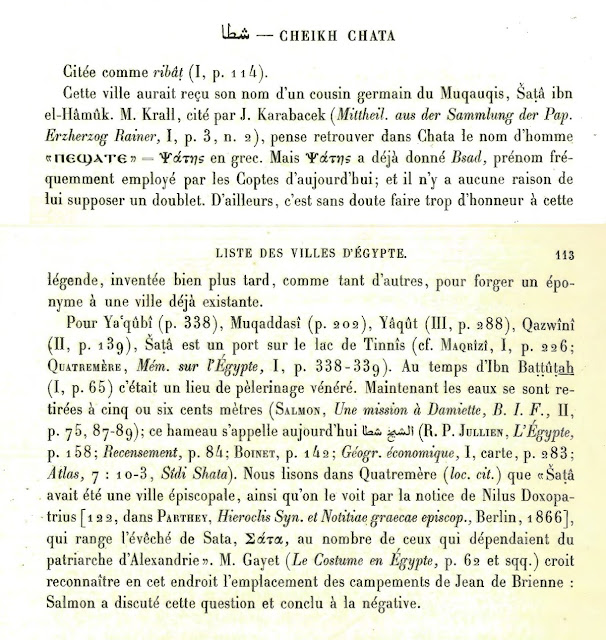 |
| شطا - CHEIKH CHATA |
Citée comme ribât (I, p. 114).
Cette ville aurait reçu son nom d'un cousin germain du Muqauqis, Satâ ibn
el-Hâmûk. M. Krall, cité par J. Karabacek (Mittheil. aus der Sammlung der Pap.
Erzherzog Rainer, I, p. 3, n. 2 📜), pense retrouver dans Chata le nom d'homme
‟ⲡⲉϣⲁⲧⲉ”= Ψάτης en grec. Mais 'Ψάτης a déjà donné Bsad, prénom fré -
quemment employé par les Coptes d'aujourd'hui; et il n'y a aucune raison de
lui supposer un doublet. D'ailleurs, c'est sans doute faire trop d'honneur à cette
légende, inventée bien plus tard, comme tant d'autres, pour forger un épo-
nyme à une ville déjà existante.
Pour Ya'qûbî (p. 338), Muqaddasî (p. 202), Yâqût (III, p. 288), Qazwînî
(II, p. 139), Satâ est un port sur le lac de Tinnîs (cf. MAQRîzî, I, p. 226;
QuATREMÈRE, Mém. sur l Egypte, I, p. 338-339)· Au temps d'Ibn Battûtah
(I, p. 65) c'était un lieu de pèlerinage vénéré. Maintenant les eaux se sont re-
tirées à cinq ou six cents mètres (SALMON, Une mission à Damiette, B. I. F., II,
p. 75, 87-89); ce hameau s'appelle aujourd'hui الشيخ شطا (R. P. JuLLIEN, L'Egypte,
p. 158; Recensement, p. 84; BoiNET, p. 142; Géogr. économique, I, carte, p. 283;
Atlas, 7 : 1 o-3, Sîdi Shata). Nous lisons dans Quatremère (loc. cit.) que ‟ Satâ
avait été une ville épiscopale, ainsi qu'on le voit par la notice de Nilus Doxopa-
trius [ 122, dans PARTHEY, Hieroclis Syn. et Notitiae graecae episcop., Berlin, 1866],
qui range l'évêché de Sata, Σάτα, au nombre der ceux qui dépendaient du
patriarche d'Alexandrie”. M. Gayet (Le Costume en Egypte, p. 62 et sqq.) croit
reconnaître en cet endroit l'emplacement des campements de Jean de Brienne :
Salmon a discuté cette question et conclu à la négative.
📜النص المشار اليه كما ورد بالألمانية مدرج هنا
Zur Vervollständigung seiner Genealogie füge ich hinzu, dass nach Makrîzî, Chith. I, 226, des Mokaukis Oheim mütterlicherseits الهاموك el-Hâmûk hiess. Schatha شطا, der Sohn des el-Hâmûk, fiel als Bundesgenosse der Sarazenen im Kampfe gegen die griechischen Truppen von Tinnis am 19. Juli 642. Schathâ ist wahrscheinlich Ψάτης (== ⲡⲉ-ϣⲁⲧⲉ); auch die Stadt Schatha, welcher er den Namen gegeben haben soll, wird als Bischoffitz Ϲάτα angeführt (J. Krall).
وترجمته للانجليزية باستخدام جوجل كما يلي:
To complete his genealogy I add that after Makrîzî, Chith. I, 226, Mokauki's maternal uncle was called الهاموك el-Hâmûk. Shatha شطا, the son of el-Hâmûk, fell as an ally of the Saracens in the battle against the Greek troops of Tinnis on July 19, 642. Shathâ is probably Ψάτης (== ⲡⲉ- ϣ ⲁⲧⲉ); also the city of Schatha, to which he is said to have given his name, is listed as a bishopric Ϲάτα (J. Krall).
English translation by "Walter G. Clewell"
CHIEKH CHATA
Cited like[1]
ribât (I, p.114).
This town would have received its name from the first cousin[2] of Muqauqis, Šatâ
ibn el-Hâmûk. M. Krall, cited by J.
Karabacek (Mittheil. aus der Sammlung der
Pap. Erzherzog Rainer[3],
I, p. 3, n.2), thought to find in Chata the man’s name ‟ⲡⲉϣⲁⲧⲉ”= Ψάτης in Greek. But 'Ψάτης already provided Bsad, a pronoun
often used by the Copts of today; and there is no reason to suppose it a
cognate. In any case, it is doing too
much honor to that legend[4],
an anachronistic invention, like so many others, to give an eponymous name to a
town that already existed before.
Same as Ya’qûbî (p.338), Muqaddasî (p.202), Yâqût (III,
p288), Qazwînî (II, p.139), Šatâ is a port on the Tinnîs Lake (see also
Maqrîzî, I, p. 226; QUATREMÈRE[5],
Memoirs of Egypt, I, p.
338-339). At the time of d’Ibn Battûtah (I,
p.65) it was a venerated destination for pilgrimage. Now the water level has dropped five or six
meters (SALMON, A Mission, B. I. F., II, p. 75, 87-89); this hamlet is called today الشيخ شطا (R. P. Jullien, Egypt, p.158; Census, p.8r; BOINET, p. 142; Economic Geography, I, map, p. 283;
Atlas, 7: 10-3, Sîdi Shata). We read in Quatremère (as cited above) that “Šatâ”
was an Episcopal[7] locale, such that
one sees it acknowledged by Nilus Doxopatrius [122, in PARTHEY, Hieroclis Syn. Et Notitiae graecae episcop.[8] Berlin, 1866], who
listed the bishopric of Sata, Σάτα, in the number of those that depended on
the diocese[9] of Alexandria. M. Gayet (The
Customs of Egypt, p. 62 on) believes he recognizes in this place evidence
of the location of the military camps of Jean de Brienne[10]: Salmon[11]
discussed this question and concluded the contrary.
[1] “similar to”
[2] Two people who have
the same grandparent
[3] “Mittheil.” is
probably mittheilen in abbreviated form so the title is worded (roughly) “Taken
from the collection of the Museum of Erzherzog Rainer”--near Vienna--not that
I’ve ever been there.
[4] Referring to
<>, whoever that is; some of my translation is not literal
here but figurative
[5] Quatremere is
likely Quincy Quatremere (famous archaeologist)--I guess the French liked their
author citations in all caps at this time
[6] A mission that a
missionary would make
[7] Going to guess that
“episcopal” here means something closer to Greek Orthodox. You’ll see why in the next note
[8] Here we have
reference to some Greek/Byzantine guys who predate what we know as the
Episcopal church of today by centuries.
Hieroclis Synekdemos is probably indicated in the title “and Noted Greek
Episcopalians”.
[9] Guessing here,
patriarche refers to the head of a station in Christian religion but I don’t
know those hierarchies very well
[10] Apparently a
crusader from France
[11] Cited author from
6, see above
- 📗 طالع أيضاً: